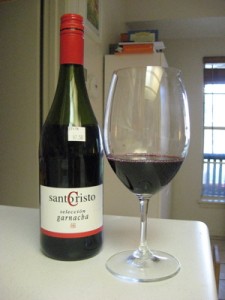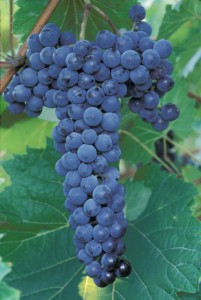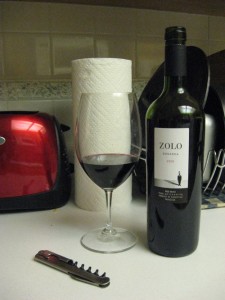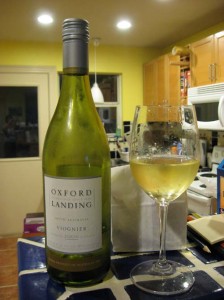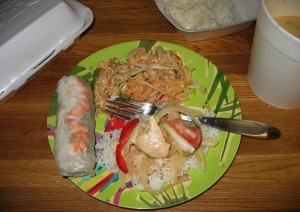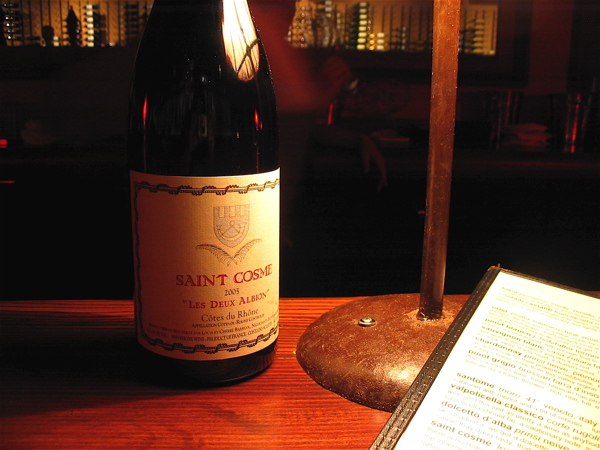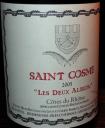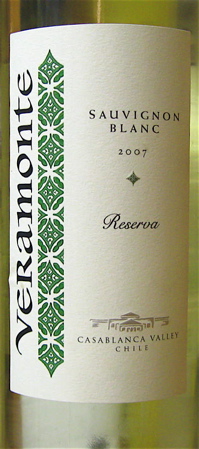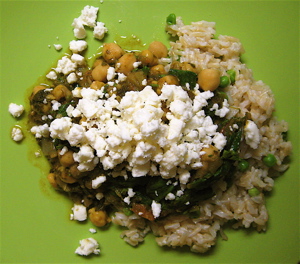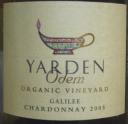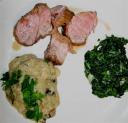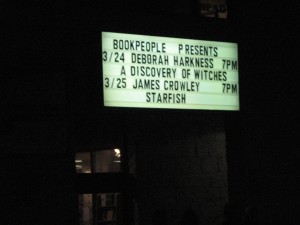 Last night I went to Book People to see fellow wine blogger and NYT bestselling novelist Deb Harkness speak about her fantastic novel, A Discovery of Witches. Go buy it. Right now. It’s OK, I’ll wait.
Last night I went to Book People to see fellow wine blogger and NYT bestselling novelist Deb Harkness speak about her fantastic novel, A Discovery of Witches. Go buy it. Right now. It’s OK, I’ll wait.
Cool. Anyway, after the talking and the signing, Deb and I went to Wink for some wine and conversation, which were equally delicious. I will comment at this point that, while Yelpers reference issues with attitude and portion size at Wink, our experience included an exceptionally warm, gregarious staff and what I considered reasonable portions. But then, we just had wine, cheese and dessert, so I’m not sure my portion size wisdom is worth much. I was very pleased with the host and our server, however – we had actually intended to just go to their wine bar, but when we stumbled in to the restaurant first, the host walked us over to the wine bar… and then offered us a table at the restaurant if we preferred. We did, as the wine bar was packed.
When reviewing Wink’s list online, I had my eye on the Schramsberg Brut Rose 2006, as I (1) love sparking wine SO MUCH, (2) love Schramsberg SO MUCH and (3) thought it was really reasonably priced on their list at $60. Seriously, it practically retails for that. (Please don’t tell Wink.)
 THEN, when Deb and discussed, I discovered that she had never tried Schramsberg’s vintage wine, which had me agog with horror (on their behalf, and hers), PLUS 2006 is when she started blogging, so it was… let’s be honest. It was Wine Fate. Sometimes Wine Fate takes hold of your life, and it’s senseless to struggle. Just let go, and let wine.
THEN, when Deb and discussed, I discovered that she had never tried Schramsberg’s vintage wine, which had me agog with horror (on their behalf, and hers), PLUS 2006 is when she started blogging, so it was… let’s be honest. It was Wine Fate. Sometimes Wine Fate takes hold of your life, and it’s senseless to struggle. Just let go, and let wine.
Schramsberg was the first winery in California to make sparkling wine, let alone methode champenoise (meaning in the style of the Champagne region) sparkling, and I still think their vintage bubbly rivals great Champagne. They’re a Napa house, though the 2006 Brut Rose contains grapes sourced from Mendocino, Napa and Sonoma. The 2006 vintage was 68% Pinot Noir and 32% Chardonnay.
Dear, dear readers – it was SO GOOD. This wine was a perfect, glittering jewel box of salmon pink, with pinpoint bubbles that never quit. The nose was of the most flawless wild strawberry on Heidi’s mountain. I confess I did not linger there because I so desperately wanted to taste… the palate was crystal clear and whistle-clean, yet simultaneously creamy and slightly spicy, with complex flavors of strawberry, apple and nectarine, and a finish that could go all night. Sublime.
We ate “lightly,” ordering the Texas cheese plate (which included CKC Farms Baby Caprino, Sand Creek Gouda, Texas Gold Cheddar, and Bosque Blue), and then going on to dessert. We had fun tasting the wine with the four cheeses, agreeing that the Baby Caprino was the best match for the wine, though the other cheeses were also very delicious. The cheddar was beautifully nutty, and the blue was fabulously rich and pungent.
Based on our experience with the cheese, we were excited about pairing the wine with Wink’s chevre cheesecake, which sits on a shortbread crust with a riesling syrup reduction, little balls ‘o pear, and candied pecans. We also got the Wink trio, which included their flourless chocolate cake, creme brulee and lemon merengue pie/confection. But mostly I need to tell you about the cheesecake.
The chevre cheesecake was, on its own, resplendent in its perfection – and with the wine, it hit a superlative level that blew us away. The tanginess of the chevre, balanced with the buttery shortbread and then mixed with the pear and the frosted nuts… THEN combining all THAT with the creamy yet crisp wine, with the pear coaxing out more of the Chardonnay than we had tasted before, transforming both the food and the bubbly… it was one of those alchemical pairing experiences, when 1 and 1 make 3, that all wine & food lovers treasure.
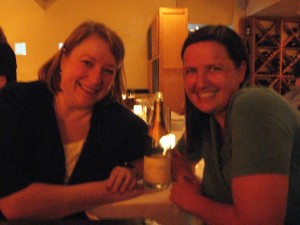 The other three desserts paled in comparison with the above, so I won’t bore you with it – but I will mention that the bubbly did a great job with the intense chocolate cake, gratifying me in my memory that Schramsberg Brut Rose is an awesome chocolate wine.
The other three desserts paled in comparison with the above, so I won’t bore you with it – but I will mention that the bubbly did a great job with the intense chocolate cake, gratifying me in my memory that Schramsberg Brut Rose is an awesome chocolate wine.
Deb and I talked of everything under the sun, including wine blogging, feminism, fiction, academia, Texas, motherhood, self-actualization and cowboy boots. The whole evening was a blast, and I am so grateful for a world that has Deb Harkness in it, both for her whip-smart, generous self and her engaging, complex fiction. Can’t wait until next time!
